By Leen Randell
Updated: Jul 10, 2024
10 Best Herbal Decoctions For Difficulty Eating
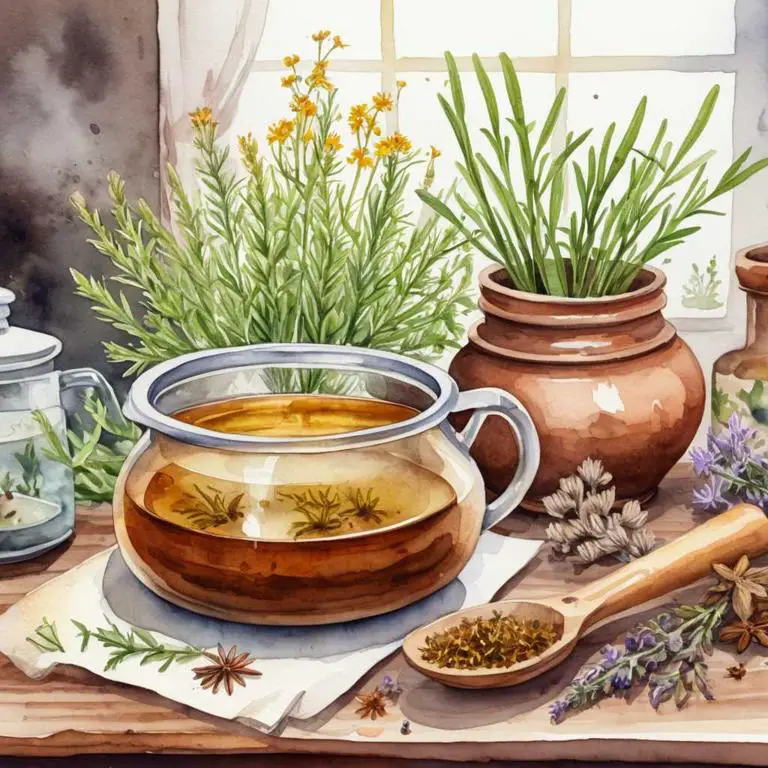
Herbal decoctions for difficulty eating are a type of natural remedy that combines herbs with hot water to create a soothing liquid extract.
These decoctions can help alleviate symptoms associated with difficulty eating, such as indigestion, bloating, and discomfort after meals. Certain herbal decoctions like ginger, peppermint, and chamomile have anti-inflammatory properties that calm the digestive system, reducing discomfort and making it easier to eat.
For example, a person with irritable bowel syndrome (IBS) may find that drinking a ginger decoction before meals helps alleviate symptoms, allowing them to enjoy their favorite foods without discomfort.
The following article describes in detail the most important decoctions for difficulty eating, including medicinal properties, parts of herbs to use, and recipes for preparations.
- 1. Glycyrrhiza glabra
- 2. Zingiber officinale
- 3. Cinnamomum verum
- 4. Foeniculum vulgare
- 5. Mentha x piperita
- 6. Rumex acetosella
- 7. Taraxacum officinale
- 8. Curcuma longa
- 9. Capsicum annuum
- 10. Marrubium vulgare
- What is the best combination of herbal decoctions to use for difficulty eating?
- What ailments similar to difficulty eating are treated with herbal decoctions?
1. Glycyrrhiza glabra
Licorice decoctions helps with difficulty eating because it soothes and calms the digestive system, reducing inflammation and irritation that can make meals uncomfortable.
The anti-inflammatory properties of licorice root also help to ease digestion, allowing for smoother passage of food through the digestive tract. Additionally, licorice decoctions have been shown to stimulate appetite, making it easier to eat and enjoy a balanced diet again.
This natural remedy provides relief from digestive discomfort, promoting a healthy and enjoyable eating experience.

Medicinal Constituents
The list below shows the primary medicinal constituents in Glycyrrhiza glabra decoctions that help with difficulty eating.
- Glycyrrhizin: Glycyrrhizin helps with difficulty eating by soothing inflammation in the digestive tract and promoting the production of stomach acid, which aids in digestion and alleviates symptoms of indigestion and nausea.
- Flavonoids: Flavonoids in Glycyrrhiza glabra decoctions help with difficulty eating by exhibiting anti-inflammatory properties that protect the mucous membranes in the digestive tract and reduce irritation, making it easier to eat and digest food.
- Terpenoids: 18α-Glycyrrhetinic acid, a terpenoid present in Glycyrrhiza glabra decoctions, helps with difficulty eating by reducing inflammation and oxidative stress in the digestive tract, which can contribute to conditions such as irritable bowel syndrome (IBS) and other eating disorders.
Parts Used
The list below shows the primary parts of licorice used to make decoctions for difficulty eating.
- Roots: They are used due to their high glycyrrhizin content, which has anti-inflammatory properties that can aid in digestion.
- Leaves: They are used as they contain flavonoids and saponins that can help soothe digestive issues.
- Roots: They are used due to their high glycyrrhizin content, which can help stimulate appetite and improve digestion.
Quick Recipe
The following recipe gives a procedure to make a basic licorice for difficulty eating.
- Weigh 10-20 grams of dried glycyrrhiza glabra roots for a standard decoction.
- Boil 500-1000 milliliters of water in a pot for approximately 5-10 minutes.
- Add the weighed glycyrrhiza glabra roots to the boiling water for 10-15 minutes.
- Remove the glycyrrhiza glabra roots from the decoction after the preparation time.
- Strain the decoction through a cheesecloth or a fine-mesh sieve into a container.
2. Zingiber officinale
Ginger decoctions helps with difficulty eating because it can soothe digestive issues, such as nausea and indigestion, that often accompany mealtime struggles.
The anti-inflammatory properties of ginger also help to reduce pain and discomfort associated with swallowing and chewing difficulties.
Additionally, the warm and comforting nature of herbal ginger decoctions can calm digestive upset and ease feelings of fullness or bloating, making it easier to enjoy meals without distress.
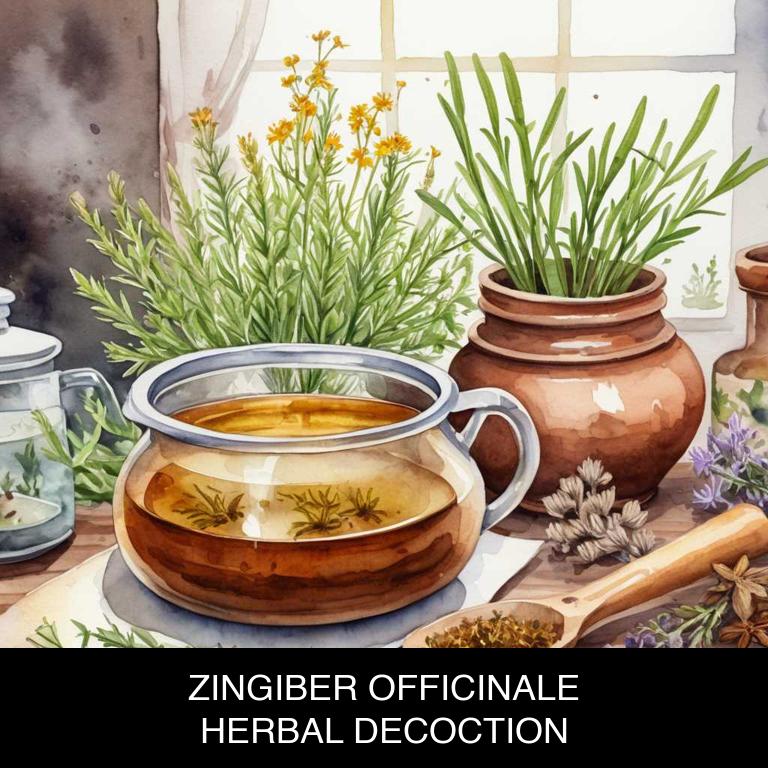
Medicinal Constituents
The list below shows the primary medicinal constituents in Zingiber officinale decoctions that help with difficulty eating.
- Gingerol: This compound helps with difficulty eating by reducing inflammation and pain in the digestive tract, making it easier to swallow and digest food.
- Shogaol: Shogaol has antioxidant and anti-inflammatory properties that help soothe the digestive system, reducing nausea and discomfort that can make eating difficult.
- Zingerone: Zingerone has a warming and anti-inflammatory effect on the digestive system, which can help alleviate nausea, bloating, and discomfort associated with eating, making it easier to consume food.
Parts Used
The list below shows the primary parts of ginger used to make decoctions for difficulty eating.
- Buds: The buds of Zingiber officinale can be used in decoctions, although less commonly than the rhizome or root, as they are believed to have a similar effect in aiding digestion and reducing nausea.
Quick Recipe
The following recipe gives a procedure to make a basic ginger for difficulty eating.
- Gather 1-2 teaspoons of dried zingiber officinale root and store it in an airtight container for future use.
- Measure 1 cup of boiling water and pour it over the dried zingiber officinale root in a heat-resistant cup.
- Allow the mixture to steep for 5-7 minutes to allow the active compounds to infuse into the water.
- Strain the liquid through a fine-mesh sieve into a cup and discard the solids after the liquid has cooled.
- Consume the decoction immediately after preparation as the bioactive compounds may degrade over time.
3. Cinnamomum verum
Ceylon cinnamon decoctions helps with difficulty eating because of its warming and soothing properties that gently stimulate the digestive system.
The decoction's anti-inflammatory compounds help reduce inflammation in the mouth, throat, and stomach, alleviating discomfort and pain associated with eating. Additionally, Ceylon cinnamon's natural sweetness and aroma can make food more appealing, increasing appetite and encouraging consumption.
As a result, individuals experiencing difficulty eating due to various factors such as digestive issues or dental problems may find relief and comfort with regular use of Ceylon cinnamon decoctions.
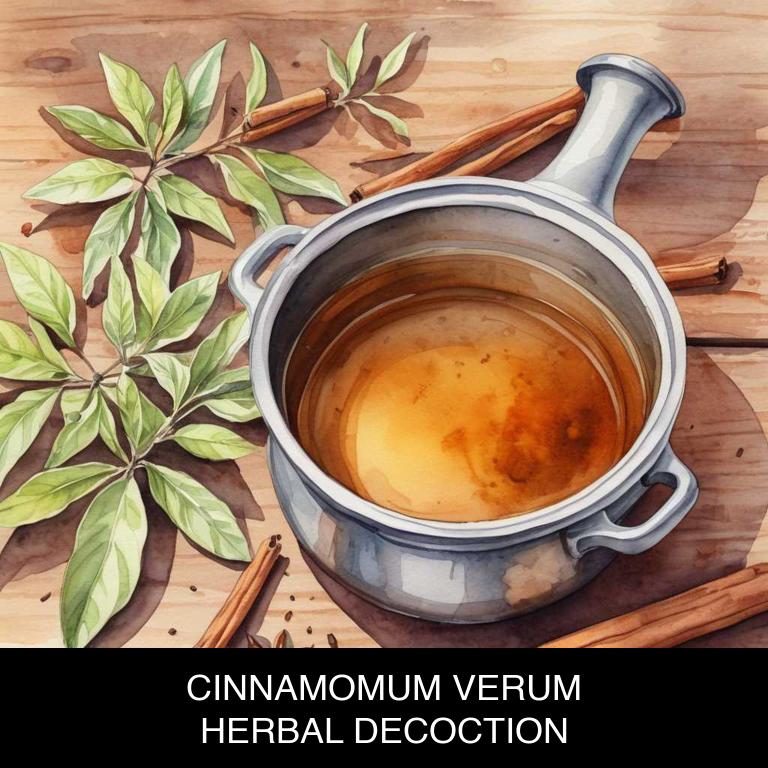
Medicinal Constituents
The list below shows the primary medicinal constituents in Cinnamomum verum decoctions that help with difficulty eating.
- Cinnamaldehyde: This phenolic compound has been shown to reduce inflammation in the digestive system, improving digestion and reducing discomfort associated with difficulty eating.
- Cinnamomin: This terpene has been found to have anti-inflammatory properties, which can help soothe digestive issues and reduce discomfort, making it easier to eat.
- Coumarin: This phenolic compound has been reported to have antioxidant and anti-inflammatory effects, which may help protect the digestive system from damage and promote healthy digestion, making it easier to eat.
Parts Used
The list below shows the primary parts of ceylon cinnamon used to make decoctions for difficulty eating.
- Leaves: The leaves of Cinnamomum verum are used to make decoctions for difficulty eating because of their carminative properties, which help ease digestion and alleviate nausea.
- Rhyzomes: The rhyzomes of Cinnamomum verum are used to make decoctions for difficulty eating because they contain compounds that help stimulate appetite and improve digestion.
- Barks: The barks of Cinnamomum verum are used to make decoctions for difficulty eating because of their warming properties, which help increase metabolism and stimulate appetite.
Quick Recipe
The following recipe gives a procedure to make a basic ceylon cinnamon for difficulty eating.
- Harvest 2-3 grams of dried cinnamomum verum bark from a reliable source.
- Grind the dried bark into a fine powder using a mortar and pestle.
- Combine the ground powder with 250ml of boiling water in a heat-resistant container.
- Steep the mixture for 5-7 minutes to allow for optimal extraction of active compounds.
- Strain the decoction through a cheesecloth or a fine-mesh sieve into a clean container.
4. Foeniculum vulgare
Fennel decoctions helps with difficulty eating because it eases digestive discomfort and inflammation in the mouth, throat, and stomach.
The anti-inflammatory properties of fennel soothe the mucous membranes, reducing irritation and pain associated with conditions like gastritis, esophagitis, and oral ulcers. Additionally, its natural carminative properties help eliminate gas and bloating, making it easier to digest food and swallow.
By addressing these underlying issues, fennel decoctions can improve appetite, reduce discomfort during meals, and promote a healthy digestive system.
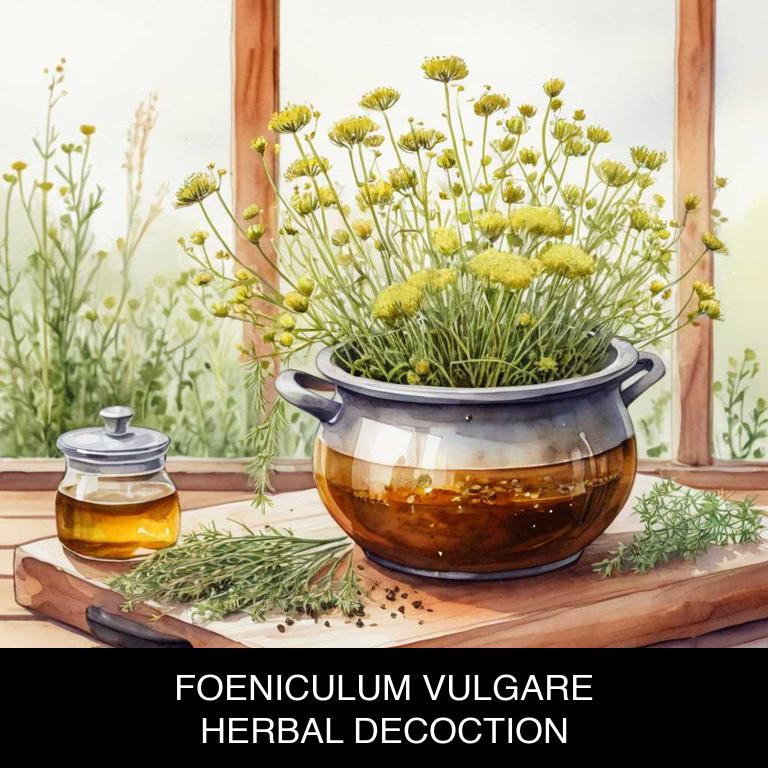
Medicinal Constituents
The list below shows the primary medicinal constituents in Foeniculum vulgare decoctions that help with difficulty eating.
- Anethole: Anethole is a terpene responsible for the carminative properties of Foeniculum vulgare, helping to ease digestive discomfort and reduce symptoms of difficulty eating.
- Lignans: Lignans present in Foeniculum vulgare have antioxidant and anti-inflammatory properties, which can help soothe the digestive system and alleviate symptoms of difficulty eating.
- Cumarins: Cumarins, specifically scopoletin, have been found to exhibit anti-inflammatory and antioxidant properties, which can help reduce inflammation in the digestive tract and alleviate symptoms of difficulty eating.
Parts Used
The list below shows the primary parts of fennel used to make decoctions for difficulty eating.
- Leaves: The leaves of Foeniculum vulgare are commonly used to make decoctions for difficulty eating due to their carminative properties, which help reduce gas and alleviate digestive discomfort.
- Seeds: The seeds are used in decoctions to aid digestion and relieve difficulty eating because they contain compounds that stimulate digestion and ease bowel movements.
- Stems: The stems of Foeniculum vulgare are used to make decoctions for difficulty eating due to their anti-inflammatory properties, which help reduce inflammation in the digestive tract and promote easy digestion.
Quick Recipe
The following recipe gives a procedure to make a basic fennel for difficulty eating.
- Gather 1 ounce of dried foeniculum vulgare root and 2 cups of water for decoction preparation.
- Combine the dried root with the water in a saucepan and bring to a boil.
- Reduce heat and simmer the mixture for 5 to 10 minutes or until the liquid reduces slightly.
- Strain the decoction through a cheesecloth or fine-mesh sieve into a clean container.
- Discard the solids and store the decoction in the refrigerator for up to 2 days.
5. Mentha x piperita
Peppermint decoctions helps with difficulty eating because its calming properties can soothe digestive issues, reducing bloating and discomfort.
The menthol in peppermint also relaxes the muscles of the esophagus, making swallowing easier and less painful. Additionally, peppermint's natural anti-inflammatory properties can reduce inflammation in the digestive tract, allowing food to pass more smoothly through the system.
By alleviating these discomforts, peppermint decoctions can help individuals with difficulty eating feel more comfortable and confident during mealtime.
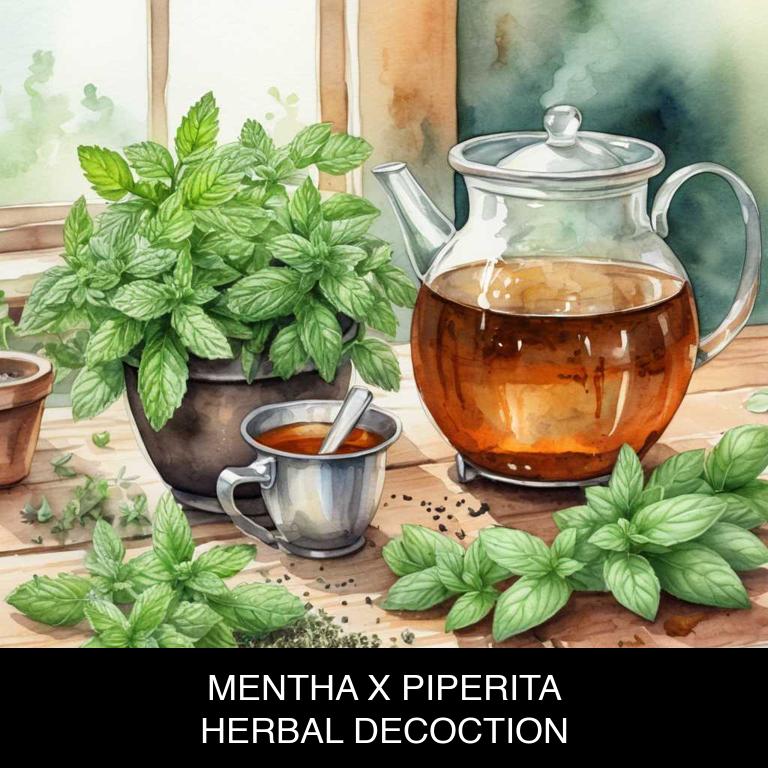
Medicinal Constituents
The list below shows the primary medicinal constituents in Mentha x piperita decoctions that help with difficulty eating.
- Menthol: Menthol is a monoterpene that helps stimulate digestion and improves appetite by increasing saliva production and gastric secretions.
- Caryophyllene oxide: Caryophyllene oxide, a sesquiterpene, has anti-inflammatory properties that can reduce inflammation in the digestive tract, making it easier to eat and digest food.
- Rosmarinic acid: Rosmarinic acid, a phenolic acid, exhibits antioxidant and anti-inflammatory properties that can soothe the digestive system, reduce nausea, and alleviate symptoms of irritable bowel syndrome (IBS), making it easier to eat and digest food.
Parts Used
The list below shows the primary parts of peppermint used to make decoctions for difficulty eating.
- Leaves: The leaves are the most commonly used part due to their high menthol content, which helps to stimulate digestion and relieve symptoms of indigestion.
- Roots: The roots are used for their carminative properties, helping to ease bloating and gas, making it easier to eat and digest food.
- Stems: The stems contain a high concentration of menthol, which aids in breaking down food and relieving nausea, making it easier to eat and digest.
Quick Recipe
The following recipe gives a procedure to make a basic peppermint for difficulty eating.
- Harvest 1-2 handfuls of fresh mentha x piperita leaves and flowers from a healthy plant.
- Chop the harvested leaves and flowers into small pieces to increase surface area.
- Combine the chopped herbs with 1 quart of boiling water in a heat-resistant container.
- Steep the herbal mixture for 5-10 minutes to allow for maximum extraction of active compounds.
- Strain the decoction through a cheesecloth or fine-mesh sieve into a clean container.
6. Rumex acetosella
Wood sorrel decoctions helps with difficulty eating because it aids in digestion and reduces inflammation, making it easier to consume food.
The natural anti-inflammatory properties of wood sorrel soothe the digestive tract, reducing discomfort and pain associated with eating. Additionally, its antibacterial properties help to eliminate harmful bacteria that can cause digestive issues.
As a result, individuals who struggle with difficulty eating may find relief in using wood sorrel decoctions as a gentle and natural solution.
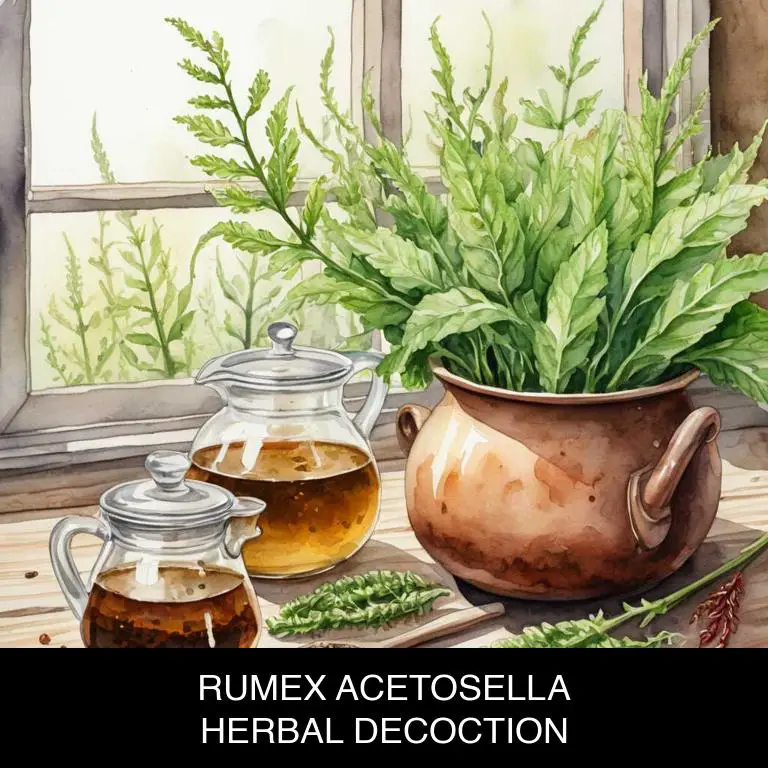
Medicinal Constituents
The list below shows the primary medicinal constituents in Rumex acetosella decoctions that help with difficulty eating.
- Flavonoids: These plant compounds help with difficulty eating by reducing inflammation in the digestive tract and promoting relaxation, which can alleviate symptoms of eating disorders such as anxiety and stress.
- Phenolic acids: These compounds have antioxidant and anti-inflammatory properties, which can help soothe digestive issues and reduce inflammation that may be contributing to difficulty eating.
- Tannins: These polyphenolic compounds can help reduce inflammation and promote healing in the digestive tract, making it easier for individuals to eat and digest food.
Parts Used
The list below shows the primary parts of wood sorrel used to make decoctions for difficulty eating.
- Leaves: They are used to make decoctions due to their astringent properties, which can help improve appetite and digestion.
- Roots: The roots are used for their bitter and astringent properties, which can aid in stimulating appetite and improving digestion.
- Stems: The stems of Rumex acetosella are used to make decoctions due to their ability to stimulate appetite and improve digestion with their bitter properties.
Quick Recipe
The following recipe gives a procedure to make a basic wood sorrel for difficulty eating.
- Harvest 1 to 2 pounds of fresh leaves and stems from rumex acetosella plants.
- Chop the harvested material into small pieces using sharp knives.
- Combine the chopped material with 2 cups of water in a saucepan.
- Bring the mixture to a boil and then reduce heat to simmer for 20 minutes.
- Strain the liquid through a cheesecloth or a fine-mesh sieve into a clean container.
7. Taraxacum officinale
Dandelion decoctions helps with difficulty eating because it has a profound impact on digestion.
The plant's leaves, stems, and roots contain bitter compounds that stimulate digestive enzymes, increasing bile production and improving gut motility. This can help alleviate symptoms of indigestion, bloating, and constipation, making it easier to digest food.
Additionally, dandelion decoctions may also help to soothe the stomach lining, reducing inflammation and discomfort associated with eating difficulties.

Medicinal Constituents
The list below shows the primary medicinal constituents in Taraxacum officinale decoctions that help with difficulty eating.
- Taraxasterol: It helps with difficulty eating by reducing inflammation in the digestive tract and promoting the healing of gastric ulcers, which can alleviate discomfort and pain associated with eating.
- Taraxanthone: It helps with difficulty eating by acting as an anti-inflammatory and antioxidant, which can soothe and protect the mucous membranes in the digestive tract, reducing irritation and discomfort that may make eating difficult.
- Inulin: It helps with difficulty eating by acting as a prebiotic, promoting the growth of beneficial gut bacteria, which can improve digestion and reduce symptoms of irritable bowel syndrome (IBS), such as bloating and abdominal pain, that may make eating uncomfortable.
Parts Used
The list below shows the primary parts of dandelion used to make decoctions for difficulty eating.
- Roots: Roots are the most commonly used part for decoctions due to their high concentration of inulin, which can aid digestion and stimulate appetite.
- Leaves: Leaves are used to make decoctions to help soothe digestive issues and stimulate appetite due to their high content of bitter compounds and flavonoids.
- Seeds: Seeds are used to make decoctions as they contain inulin and other compounds that can help stimulate digestion and alleviate digestive issues, making it easier to eat.
Quick Recipe
The following recipe gives a procedure to make a basic dandelion for difficulty eating.
- Harvest 10-20 fresh taraxacum officinale leaves and roots on a dry morning after dew has evaporated.
- Chop 2 tablespoons of taraxacum officinale leaves and roots into small pieces with a knife.
- Combine chopped taraxacum officinale with 500ml of boiling water in a saucepan and reduce heat.
- Steep taraxacum officinale in boiling water for 5-10 minutes or until desired strength is achieved.
- Strain the decoction through a cheesecloth or fine-mesh sieve into a clean container immediately.
8. Curcuma longa
Turmeric decoctions helps with difficulty eating because it soothes digestive issues that can make mealtime a chore.
The anti-inflammatory properties of turmeric help to reduce inflammation in the gut, making it easier for the body to digest food. Additionally, turmeric's natural antimicrobial and antifungal agents work to balance the gut microbiome, which is essential for proper digestion.
This results in a decrease in symptoms such as bloating, discomfort, and digestive pain, allowing individuals to enjoy their meals without distress.
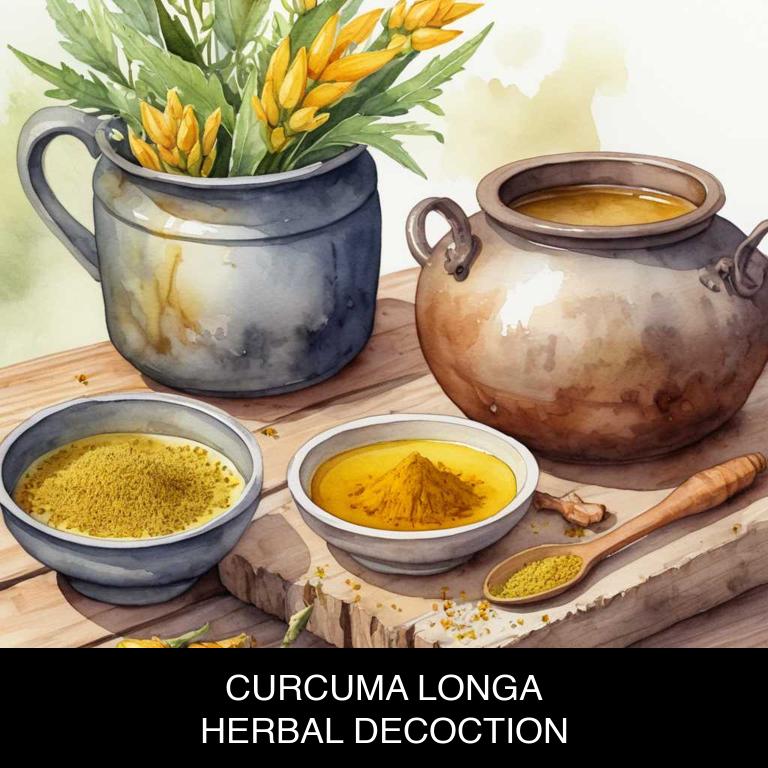
Medicinal Constituents
The list below shows the primary medicinal constituents in Curcuma longa decoctions that help with difficulty eating.
- Curcumin: Curcumin, a polyphenolic compound, helps alleviate difficulty eating by reducing inflammation and oxidative stress in the digestive system, thereby improving digestion and reducing discomfort.
- Demethoxycurcumin: Demethoxycurcumin, a curcuminoid, assists in easing difficulty eating by modulating the gut microbiome, reducing bacterial overgrowth, and alleviating symptoms of irritable bowel syndrome (IBS).
- Turmerone: Turmerone, a sesquiterpene, contributes to the improvement of difficulty eating by reducing symptoms of nausea and vomiting through its anti-inflammatory and antioxidant properties, thereby making eating more comfortable.
Parts Used
The list below shows the primary parts of turmeric used to make decoctions for difficulty eating.
- Rhyzomes::
- Roots::
- Leaves::
Quick Recipe
The following recipe gives a procedure to make a basic turmeric for difficulty eating.
- Harvest 1-2 roots of curcuma longa with a diameter of 1-2 cm and clean them thoroughly.
- Cut the roots into small pieces and soak them in 500ml of water for 30 minutes to 1 hour.
- Boil the soaked root pieces in 500ml of water for 10-15 minutes to release the active ingredients.
- Strain the decoction through a cheesecloth or a fine-mesh sieve into a clean container.
- Let the decoction cool to room temperature and store it in the refrigerator for up to 3 days.
9. Capsicum annuum
Bell pepper decoctions helps with difficulty eating because it aids in digesting food, relieving digestive discomfort, and soothing stomach issues.
The antioxidants and anti-inflammatory properties present in bell peppers help to reduce inflammation in the gut, making it easier for the body to absorb nutrients. This can be especially beneficial for individuals experiencing dyspepsia, irritable bowel syndrome, or other gastrointestinal disorders that make eating a challenging task.
By promoting healthy digestion, bell pepper decoctions can improve overall digestive health and alleviate difficulty eating.
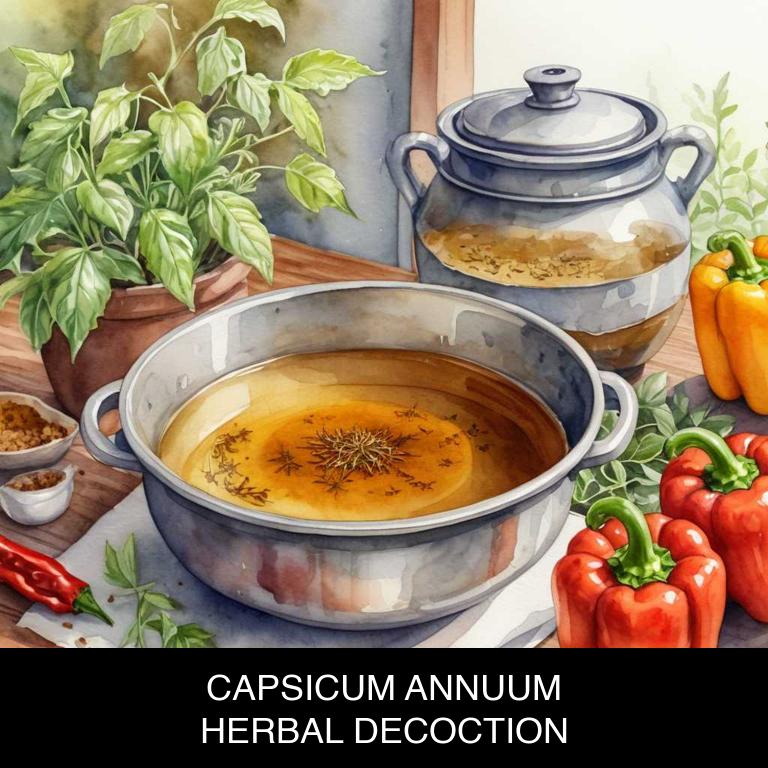
Medicinal Constituents
The list below shows the primary medicinal constituents in Capsicum annuum decoctions that help with difficulty eating.
- Capsaicin: Capsaicin is a potent analgesic and anti-inflammatory compound that helps stimulate digestion and relieve pain associated with eating, such as esophageal pain or dysphagia.
- Capsaicinoids: Capsaicinoids, including capsaicin and dihydrocapsaicin, have been shown to increase gastric motility and enhance digestion, making it easier to eat and digest food.
- Carotenoids: Carotenoids, such as beta-carotene and capsanthin, have antioxidant and anti-inflammatory properties that help protect the digestive tract from oxidative stress and inflammation, promoting a healthy digestive environment and making eating easier.
Parts Used
The list below shows the primary parts of bell pepper used to make decoctions for difficulty eating.
- Leaves: Used due to their high content of vitamins and minerals that aid in digestion and relieve stomach discomfort.
- Fruits (or more specifically, the ripened part of the fruit, the pepper): Used as it contains capsaicin, which helps stimulate digestion and relieve pain associated with eating.
- Seeds: Used due to their ability to aid in digestion and relieve constipation, as they are high in fiber and have anti-inflammatory properties.
Quick Recipe
The following recipe gives a procedure to make a basic bell pepper for difficulty eating.
- Gather 30-40 grams of dried capsicum annuum and 1 liter of water for decoction.
- Chop the dried capsicum annuum into small pieces and mix with water.
- Boil the mixture at 100 degrees celsius for 10-15 minutes to extract active compounds.
- Strain the decoction through a cheesecloth or a fine-mesh sieve to remove solids.
- Transfer the strained decoction to a clean container and store in a cool dark place.
10. Marrubium vulgare
Horehound decoctions helps with difficulty eating because it has natural expectorant properties that loosen and clear mucus from the throat, making breathing and swallowing easier.
The soothing properties of horehound also reduce inflammation and irritation in the esophagus and mouth, allowing for a smoother passage of food.
Additionally, horehound's anti-inflammatory compounds help to calm digestive issues that may contribute to eating difficulties, promoting a more comfortable and enjoyable eating experience.
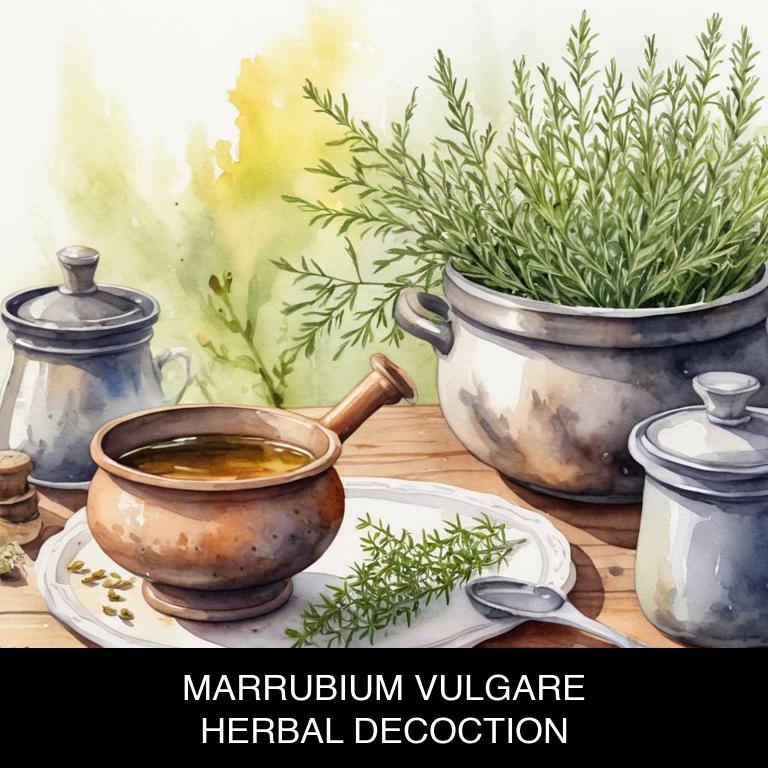
Medicinal Constituents
The list below shows the primary medicinal constituents in Marrubium vulgare decoctions that help with difficulty eating.
- Alkaloids: Specifically, Marrubium vulgare contains marrubiin, an alkaloid that has been shown to have anti-inflammatory properties, which may help reduce swelling in the digestive tract and alleviate difficulty eating caused by inflammation.
- Iridoid glycosides: These compounds, including marrubiin, have been found to have anti-inflammatory and antioxidant effects, which may help soothe digestive issues such as gastroesophageal reflux disease (GERD) and reduce discomfort associated with difficulty eating.
- Triterpenoids: Marrubium vulgare contains triterpenoids like ursolic acid, which have been shown to have anti-inflammatory and antioxidant properties that may help reduce inflammation and promote healing in the digestive tract, alleviating symptoms of difficulty eating.
Parts Used
The list below shows the primary parts of horehound used to make decoctions for difficulty eating.
- Leaves: The leaves of Marrubium vulgare are commonly used in decoctions to aid digestion and ease difficulty eating due to their carminative and anti-inflammatory properties.
- Roots: The roots are used in decoctions to treat digestive issues, including difficulty eating, by reducing inflammation and soothing the digestive system.
- Stems: The stems of Marrubium vulgare are sometimes used in decoctions to help alleviate difficulty eating by reducing inflammation and promoting digestive health.
Quick Recipe
The following recipe gives a procedure to make a basic horehound for difficulty eating.
- Harvest 250 grams of fresh marrubium vulgare leaves and flowers at dawn to ensure optimal potency retention.
- Dry the collected marrubium vulgare material in a low-temperature oven at 60 degrees celsius for 2 hours.
- Grind 50 grams of dried marrubium vulgare leaves and flowers into a fine powder using a mortar and pestle.
- Steep 1 teaspoon of the powder in 250 milliliters of boiling water for 10 to 15 minutes to create a decoction.
- Strain the decoction through a cheesecloth or a fine-mesh sieve into a clean glass container for consumption.
What is the best combination of herbal decoctions to use for difficulty eating?
The best combination of herbal decoctions that help with difficulty eating is a blend of Peppermint, Ginger, and Licorice root.
Peppermint's digestive-aiding properties ease discomfort and nausea, while Ginger's warming and anti-inflammatory effects soothe the stomach and promote appetite. Licorice root's adaptogenic properties balance digestion and reduce stress, making it easier to eat and enjoy meals.
This harmonious blend of herbs promotes a healthy digestive system, alleviates symptoms of difficulty eating, and supports overall well-being.
What ailments similar to difficulty eating are treated with herbal decoctions?
Ailments similar to difficulty eating that are treated with herbal decoctions are indigestion, bloating, and constipation.
Herbs like ginger, chamomile, and peppermint are commonly used to soothe digestive issues by calming the stomach and intestines, reducing inflammation, and stimulating digestion.
Other herbs like dandelion root and senna leaf can help alleviate symptoms of constipation by promoting bowel movements and softening stool.